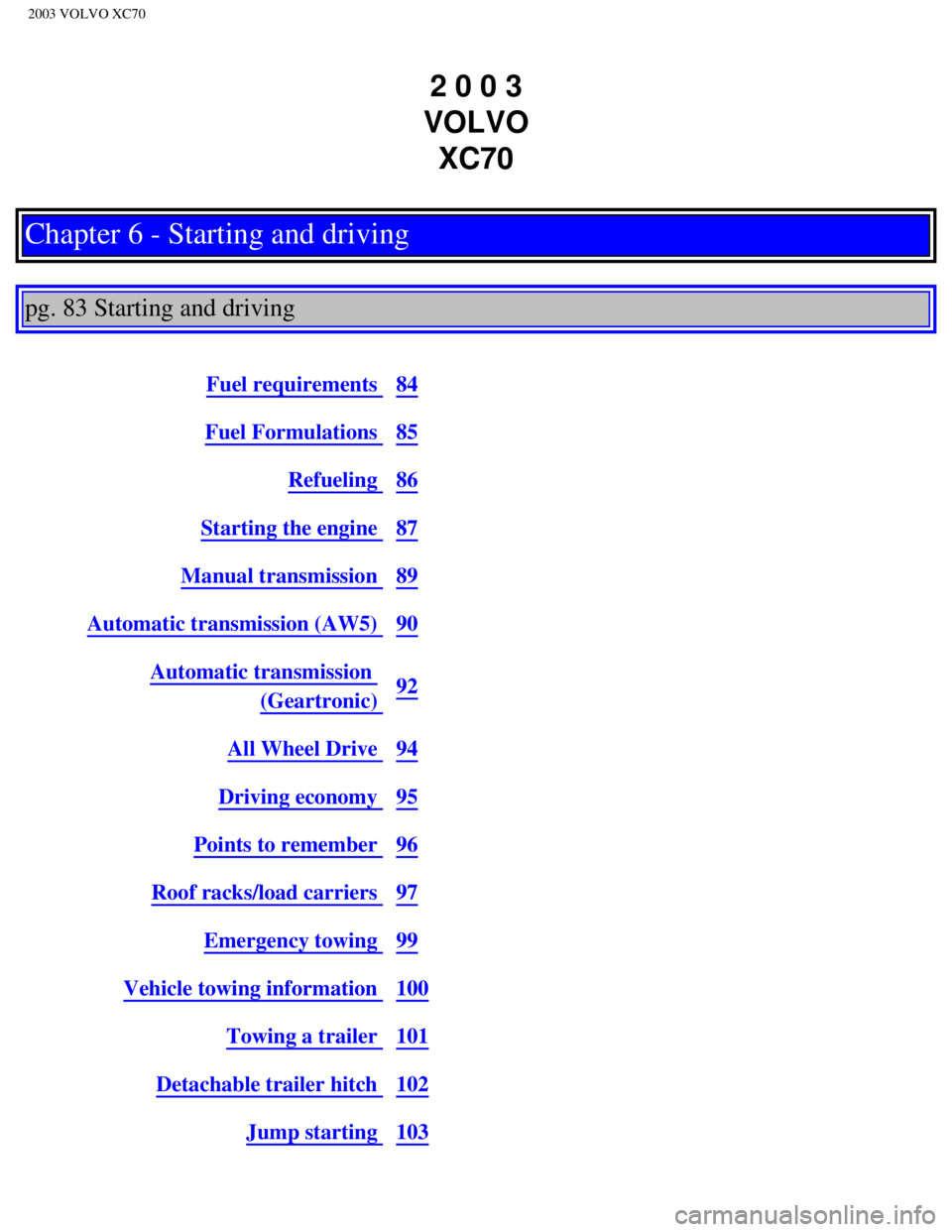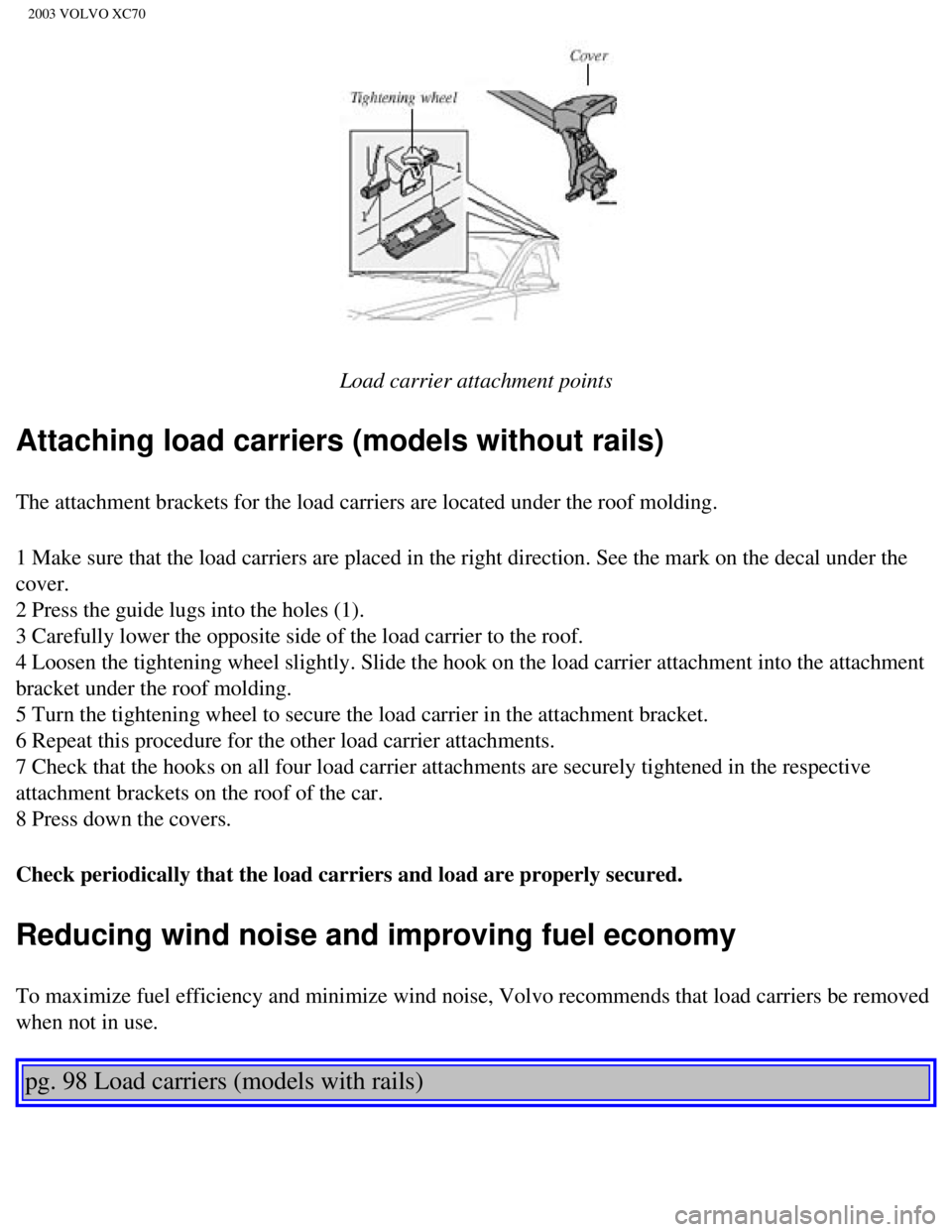2003 VOLVO XC70 roof rack
[x] Cancel search: roof rackPage 124 of 257

2003 VOLVO XC70
2 0 0 3
VOLVO XC70
Chapter 6 - Starting and driving
pg. 83 Starting and driving
Fuel requirements 84
Fuel Formulations 85
Refueling 86
Starting the engine 87
Manual transmission 89
Automatic transmission (AW5) 90
Automatic transmission
(Geartronic) 92
All Wheel Drive 94
Driving economy 95
Points to remember 96
Roof racks/load carriers 97
Emergency towing 99
Vehicle towing information 100
Towing a trailer 101
Detachable trailer hitch 102
Jump starting 103
file:///K|/ownersdocs/2003/2003_XC70/03xc70_06a.htm (1 of 22)12/30/200\
6 4:17:59 PM
Page 139 of 257

2003 VOLVO XC70
pattern, load-, speed-, traction-, temperature-, and treadwear rating. N\
ever drive on mixed tires, except
for brief periods when the temporary spare tire is in use.
Always use properly inflated tires of correct dimensions. Tire size and \
inflation pressures are shown on
the tire pressure label located inside the fuel filler door.
Tire Rotation
Volvo recommends rotating the tires every 7,500 miles (12,000 km). Tir\
es should be rotated front-to-
back/back-to-front only. Tires must maintain the same direction of rotat\
ion throughout their lifetime, and
should never be rotated from one side of the vehicle to the other.
Temporary Spare
The temporary spare tire is for temporary, low-speed, short-distance use\
only. Replace it with a full-
sized tire as soon as possible, in accordance with "Tire Rotation" above\
. Do not drive on the temporary
spare at speeds above 50 m.p.h. (80km/h) or for distances greater than\
50 miles (80 km).
Never install snow chains on a temporary spare.
pg. 95 Driving economy
Economical driving conserves natural resources
Better driving economy may be obtained by thinking ahead, avoiding rapid\
starts and stops and
adjusting the speed of your vehicle to immediate traffic conditions. Obs\
erve the following rules:
l Bring the engine to normal operating temperature as soon as possible by \
driving with a light foot on
the accelerator pedal for the first few minutes of operation. A cold eng\
ine uses more fuel and is subject
to increased wear.
l Whenever possible, avoid using the car for driving short distances. This\
does not allow the engine to
reach normal operating temperature.
l Drive carefully and avoid rapid acceleration and hard braking.
l Do not exceed posted speed limits.
l Avoid carrying unnecessary items (extra load) in the car.
l Maintain correct tire pressure. Check tire pressure regularly (when tir\
es are cold).
l Remove snow tires when threat of snow or ice has ended.
l Note that roof racks, ski racks, etc., increase air resistance and also \
fuel consumption.
l Avoid using automatic transmission kickdown feature unless necessary.
l Avoid using the air conditioning when it is not required. When engaged, \
the conditioner's compressor
places an additional load on the engine. However, at higher driving spee\
ds, fuel consumption will be
file:///K|/ownersdocs/2003/2003_XC70/03xc70_06a.htm (16 of 22)12/30/20\
06 4:18:00 PM
Page 142 of 257

2003 VOLVO XC70
Electrical system
When replacing the battery or when carrying out work involving the elect\
rical system, the following
should be observed:
l A battery connection to the wrong terminal will damage the electrical sy\
stem. Be sure to connect the
positive battery cable to the positive battery terminal and the negative\
battery cable to the negative
battery terminal.
l If booster batteries are used for starting, they must be properly connec\
ted to minimize the risk of the
electrical system being damaged. For correct connection, see "Jump start\
ing" section.
l Never disconnect the battery circuit (for example, to replace the batte\
ry) while the engine is running,
as this may damage the generator. Always make sure that all the battery \
connections are properly
cleaned and tightened.
l If any electrical welding work is performed on the vehicle, the battery'\
s ground lead (negative cable)
and all the connecting cables of the generator must be disconnected and \
the welder cables placed as near
the welding points as possible.
l The radio must be turned off before the battery is disconnected.
l Switch off the ignition for at least 10 minutes before disconnecting the\
battery.
pg. 97 Roof racks/Load carriers
Load carriers (accessory)
Load carriers are available as Volvo accessories. Observe the following \
points when in use:
l To avoid damaging your car and to achieve maximum safety when driving, w\
e recommend using the
load carriers that Volvo has developed especially for your car.
l Volvo-approved removable roof racks are designed to carry the maximum al\
lowable roof load for this
vehicle: 220 lbs (100 kg). For Non-Volvo roof racks, check the manufac\
turer's weight limits for the rack.
l Never exceed the rack manufacturer's weigh limits and never exceed the m\
aximum rated roof load of
220 lbs (100 kg).
l Avoid single-point loads. Distribute loads evenly.
l Place heavier cargo at the bottom of the load.
l Anchor the cargo correctly with appropriate tie-down equipment.
l Check periodically that the load carriers and load are properly secured.\
l Remember that the car's center of gravity and handling change when you c\
arry a load on the roof.
l The car's wind resistance (and correspondingly, fuel consumption) will\
increase with the size of the
load.
l Drive smoothly. Avoid rapid starts, fast cornering and hard braking.
file:///K|/ownersdocs/2003/2003_XC70/03xc70_06a.htm (19 of 22)12/30/20\
06 4:18:00 PM
Page 143 of 257

2003 VOLVO XC70
Load carrier attachment points
Attaching load carriers (models without rails)
The attachment brackets for the load carriers are located under the roof\
molding.
1 Make sure that the load carriers are placed in the right direction. Se\
e the mark on the decal under the
cover.
2 Press the guide lugs into the holes (1).
3 Carefully lower the opposite side of the load carrier to the roof.
4 Loosen the tightening wheel slightly. Slide the hook on the load carri\
er attachment into the attachment
bracket under the roof molding.
5 Turn the tightening wheel to secure the load carrier in the attachment\
bracket.
6 Repeat this procedure for the other load carrier attachments.
7 Check that the hooks on all four load carrier attachments are securely\
tightened in the respective
attachment brackets on the roof of the car.
8 Press down the covers.
Check periodically that the load carriers and load are properly secured.\
Reducing wind noise and improving fuel economy
To maximize fuel efficiency and minimize wind noise, Volvo recommends th\
at load carriers be removed
when not in use.
pg. 98 Load carriers (models with rails)
file:///K|/ownersdocs/2003/2003_XC70/03xc70_06a.htm (20 of 22)12/30/20\
06 4:18:00 PM
Page 205 of 257

2003 VOLVO XC70
All specifications are subject to change without prior notice.
pg. 143 Dimensions and weights
Dimensions
Length - 185.4 in. (471 cm), XC70 -186.2 (473 cm)
Width - 71 in. (180 cm), XC70 - 73.2 in. (186 cm)
Height - 57.5 in. (147 cm), V70 AWD - 58.7 in. (149 cm), XC70 - 61.5\
in. 156 cm)
Wheelbase - 108.5 in. (276 cm), XC70 - 108.8 in. (276 cm)
Track, front - 61.5 in. (156 cm), XC70 - 63.4 in. (161 cm)
Track, rear - 61.4 in. (156 cm), XC70 - 60.9 in. (155 cm)
Turning circle (between curbs) - 35.8-39 ft. (10.9-11.9 m)
Cargo capacity - 17.1 cu. ft. (0.48 m
3 ) 1
- 26.3 cu. ft. (0.74 m
3 ) 2
- 58.0 cu. ft. (1.64 m
3 ) 3
USA Canada
Max roof load 220 lbs 100 kg
Max trailer weight (w/o
brakes) 1100 lbs
500 kg
Max trailer weight*
- (with brakes, 2" ball) 3300
lbs 1500 kg
- (with brakes, 1 7/8" ball) 2000
lbs 900 kg
Max tongue weight * 165 lbs 75 kg
WARNING!
When adding accessories, equipment, luggage and other cargo to your vehi\
cle, the total loaded weight
capacity of the vehicle must not be exceeded.
1) Rear seat backrest up, load height - upper edger of backrest
2) Rear seat backrest folded down, load height - upper edge of front se\
at backrests/lower edge of rear
window
3) Rear seat backrest folded down, load height - headlining (ceiling)\
Weights USA Canada
file:///K|/ownersdocs/2003/2003_XC70/03xc70_09.htm (3 of 11)12/30/2006\
4:18:05 PM
Page 250 of 257

2003 VOLVO XC70
Rear window - heated 38
Rearview mirror
41
Refrigerant
47
Refueling
86
Remote central locking system and sideview mirrors
system
41
Remote control - keyless entry system
77
Remote control - Homelink® Universal Transceiver
168
Remote keyless entry system
77
Remote keyless entry system - replacing batteries
78
Remote keyless entry system and driver's seat
57
Removing the seat cushion
66
Replacing bulbs
120-125
Replacing fuses
116
Replacing wiper blades
140
Road assistance
149
Roadholding
95
Roof load - maximum
143
Roof racks
97
S
Safety locks - child
82
Seat belt maintenance
17
Seat belts
2, 3, 14
Seat belts - cleaning
128
Seats - front
56
Securing cargo
68
Servicing
133
Shiftlock
87, 90, 92
Side direction indicator - replacing
123
Side impact airbag system (SIPS)
8
Sideview mirrors
41
Sideview mirrors - heated
38
file:///K|/ownersdocs/2003/2003_XC70/03xc70_12.htm (9 of 12)12/30/2006\
4:18:09 PM